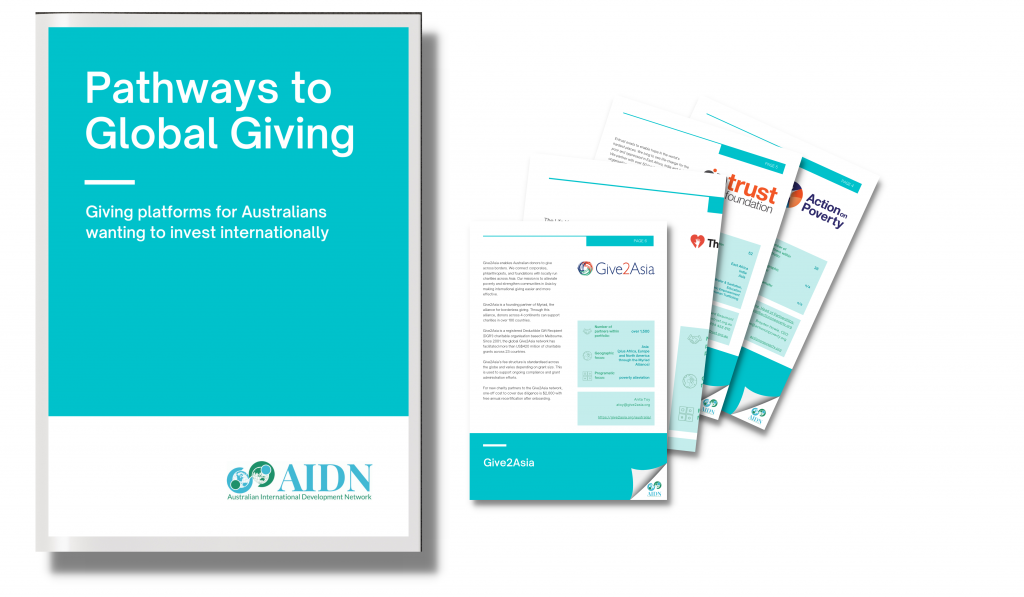In this special edition three-part blog series, the team at Australian International Development Network (AIDN) argue that the case for global giving has never been more compelling.
This series is based on AIDN’s three-part flagship series ‘The Compelling Case for Global Giving’ and was co-authored by Mark Cubit, Hannah McNicol and Emily Umbers
In Part 1 of this special series, the Australian International Development Network (AIDN) team argued that there has never been a more compelling case for global giving. On the other hand, in Part 2, AIDN explained that international giving continues to be hindered by persistent and inflated barriers. Part 2 advocated for a decisive and swift break down of these barriers. To round off this series, we are pleased to explore the ‘how’ and provide a blue-print for the first steps Australians should take in their global giving journey. By that we mean how Australians can best give to overseas causes, whilst ensuring engagement and impact, and simultaneously fostering trust and flexibility for the organisations on-the-ground.
1. Get to know an NGO or connect with other funders
Donors can have multiple and mixed motivations for giving and these can vary over time (Becker and Murphy 2000). A person’s motivations may be underpinned by a sense of morality and ethics. Or their sense of giving might be related to family or faith and religion (Charities Aid Foundation 2013). The amount people give may also reflect financial incentives, such as personal income tax. What we do know is that there will be a NGO, charity or development organisation out there that will align with your unique and diverse motivations. Importantly, most organisations will be happy to hear from or elucidate what they do to a similarly passionate individual or potential donor. If you’re feeling unsure about global giving, simply take a moment to learn more, connect with and be inspired by the organisations out there and their incredible operations.
Indeed, giving is a social process that both connects us to but is also impacted by the actions of our community. For example, Peter Singer explains that ‘one of the most significant factors in determining whether people give to charity is what others are doing’ (Singer, Guardian 2008). Accordingly, we also encourage potential donors to tap into giving networks like AIDN. This will allow you to connect with like-minded funders or change-makers and realise you’re part of a wider giving community. In fact, funding networks are often willing to share their own experiences or due diligence with other potential donors. For example, check out AIDN’s Pathways to Global Giving which links donors to various organisations who have portfolios of overseas partners and includes extensive due diligence protocols.

2. Start with funding one international group and see how it goes
Part 2 of this series explained that there are a number of obstacles that continue to obstruct the healthy flow of giving to international causes from Australia. These obstacles include concerns surrounding impact and effectiveness, ensuring tax deductibility and a low awareness around Australia’s charity regulatory environment. These concerns, whilst inflated, are stubborn and even sophisticated donors remain more timid when it comes to the global chapter of their giving portfolio. However, like with all good investments, start your global giving journey slowly. Fund one international group and…simply see how it goes!
This idea of ‘dipping your toes in’ and building confidence with a view to giving more in the future is already a blossoming trend in the (international) impact investing sector. Since inception Red Hat Impact has promoted the power of crowd equity. They allow syndicates of investors ranging from $500 to $75k to come together and support impact enterprises collectively. Similarly, organisations like Kiva are allowing sums as small as $25 to be aggregated in a way that can create meaningful sums of money to microfinance institutions whilst simultaneously lowering the entry price for individuals to make initial impact investments.
3. Cultivate a trust-based relationship
As flagged in Part 2, trust also continues to hinder the level of outbound giving to international causes. For example, donors may be worried about how their donation is being used overseas. To temper this issue, Part 2 highlighted the numerous resources available to evaluate the effectiveness of charities, such as ChangePath or the Australian Charity and Not-for-Profit Commission’s charity register. However, what many may not realise is that fostering a sense of trust is also increasingly being shown to be vital to the inherent sustainability of charities themselves. Bottom-up approaches and ‘trust-based philanthropy’ allow charities to be creative, agile and to respond to the complex issues they are striving to challenge. Trust-based philanthropy often involves simpler reporting requirements or cutting back on grant restrictions (Rush, National Philanthropic Trust, 2022). At the heart of trust-based philanthropy, however, is a commitment to rebalancing power, democratising decision-making and fostering processes of localisation. As Phil Buchanan, president of The Center for Effective Philanthropy, explains it is ‘those talented people in nonprofits working closest to communities who know best what is needed and how to do it’ (Gamboa, 2023).
4. Offer unrestricted funding and ask your grantees what the impact of untied grants are for them
Building on the above, the Center for Effective Philanthropy recently explored the impact of large, unrestricted grants on nonprofits over five years. In a context where the idea of such grants still feel ‘risky’ to many donors – they found that unrestricted ‘funds created space for leaders to lead, built morale within the organisation and allowed for re-granting or other forms of collaboration across the broader field’ (Fleming, Abril, Bradach – CEP 2023).
In sum, we encourage Australians looking to start their global giving journey to donate or invest with impact and trust, and allow these organisations the required flexibility to expand their programs, innovate and scale. It is amazing what these organisations are capable of when given the space to flourish.
5. Consider a trip to the field to see the work in action, if possible
Finally, an in-person trip to the organisation you want to support is a fantastic way to set the wheels in motion for a sustainable overseas giving agenda. Not only will it foster that intimate connection many donors seek to the cause they care about but donors will also undoubtedly meet a range of inspiring leaders and change-makers while they’re there. When an in-person visit is not possible or appropriate, think creatively about how to enhance engagement – from zoom to seeking out other like minded funders to tuning into relevant podcasts such as AIDN’s philanthropod!
Equipped with this key information, we are excited to meet more Australians on the global giving journey.
